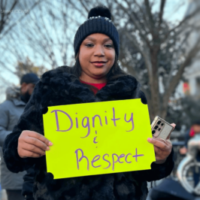Available in Spanish
Introduction
In the United States, we face a crisis of workplace abuses. Researchers estimate that wage theft costs workers more than $50 billion per year.[1] Inequality has increased in direct relationship to the decline in union membership,[2] with union representation rates at an all-time low.[3] Several states across the country are currently seeking to dissolve child labor laws.[4]
Immigrant workers, especially immigrant workers of color, are at the forefront of this crisis of workplace abuse. This crisis is fueled by direct attacks from employers, corporations, politicians, and courts that have functionally eroded immigrant worker rights, establishing a more vulnerable class of workers: undocumented and temporary visa migrant workers who are subjected to some of the most severe forms of workplace abuse.[5]
In addition, workplace raids such as the New Bedford raid[6] and the Mississippi raids[7] have created long-lasting trauma that has silenced many immigrant workers who, as a result of these raids, see labor enforcement and negative immigration consequences as one and the same. This political and legal context has facilitated abuse by employers who use workers’ immigration status to severely undermine undocumented and other immigrant workers’ rights and their organizing efforts.
In the face of these workplace abuses, immigrant worker leaders, organizers, and advocates have long pressed the federal labor agencies and the United States Department of Homeland Security (DHS) to keep immigration enforcement out of the workplace, and to collaborate to provide immigrant workers protections so they can fully exercise their workplace rights. Most recently, because of these collective efforts, the National Labor Relations Board (NLRB)[8] and the U.S. Department of Labor (DOL)[9] made announcements in 2021 and 2022 respectively, reaffirming their commitments to enforce the rights of all workers and to support immigrant workers in seeking deferred action protections from DHS. Then, in January 2023, DHS announced a streamlined process for workers to seek deferred action protections based on federal, state, or local labor agencies’ enforcement interests.[10] Deferred action protections via prosecutorial discretion based on labor disputes have long existed.[11] But prior to January 2023, DHS had not provided workers with any centralized and transparent application process to seek them. DHS and labor agencies’ collaboration on this key worker protection represents a significant organizing and advocacy victory. This is a critical step towards true justice for immigrant workers.
As a result of these hard-fought victories, there are new opportunities for workers to organize, build power, and collaborate with labor agencies in holding employers accountable for harm and violating the law. We created this resource based on our experiences and lessons learned from piloting the expansion of deferred action protections at Arriba Las Vegas Worker Center; accompanying additional labor disputes across the country; representing immigrant workers in a diverse range of labor disputes before labor agencies and courts; and advocating with labor agencies and DHS to effectively implement the deferred action protections process. We hope this guide serves to further expand the effective use of deferred action protections for immigrant workers.
This guide is intended as a resource for organizers and workers’ rights attorneys who are considering how deferred action protections might strengthen immigrant workers’ efforts to combat labor abuse, build power, and organize to enforce workplace rights. First, the guide provides an overview of deferred action protections based on labor disputes, including information on eligibility criteria; how to seek support from a labor agency; and the five main steps in the process. For each of the five steps, we provide more detailed information on 1) how to collaborate with workers to identify labor violations and the corresponding agencies, while building worker power in the process; 2) how to file labor agency complaints and secure strong labor agency investigations; 3) how to obtain a labor agency Statement of Interest (SOI), including more detailed information on what this is and important tips for engaging workers in this process; 4) what to do after obtaining the SOI, including engaging workers about the SOI, integrating immigration practitioners into the team so workers can apply for deferred action protections, and thinking about deferred action renewals and permanent forms of immigration relief based on labor disputes; and finally, 5) how to continue organizing efforts and prepare for next steps in the legal process to build worker power and ultimately achieve a successful resolution of the labor dispute. We also discuss strategies to build the team; the importance of effective relationships between worker leaders, organizers, and lawyers; and strategies to protect workers’ confidential information.
This guide does not provide legal advice and, because it is not designed for immigration practitioners, it does not provide information on how to file a worker’s deferred action application with DHS. That said, we welcome immigration practitioners to review this guide to better understand the process of securing deferred action protections for labor enforcement interests in order to collaborate more effectively with workers’ rights advocates. For a full description of best practices for immigration practitioners when engaging in the immigration side of the deferred action protections process, please consult the Practice Manual: Labor-Based Deferred Action (referenced throughout as the “Immigration Practice Manual”).[12]
Download the report to read more.
Endnotes
[1]. Brady Meixell and Ross Eisenbrey, “An Epidemic of Wage Theft Is Costing Workers Hundreds of Millions of Dollars a Year,” September 11, 2014, https://www.epi.org/publication/epidemic-wage-theft-costing-workers-hundreds/.
[2]. Thomas A. Kochan et al., “Workers and Employers at a Crossroads: A Summary Report from a Multistakeholder Dialogue on U.S. Worker Voice and Representation” (Worker Empowerment Research Network, March 16, 2023), https://mitsloan.mit.edu/centers-initiatives/institute-work-and-employment-research/workers-and-employers-a-crossroads-report-published; Henry S. Farber et al., “Unions and Inequality Over the Twentieth Century: New Evidence from Survey Data” (National Bureau of Economic Research, May 2018), https://www.nber.org/system/files/working_papers/w24587/w24587.pdf.
[3]. “Union Membership Rate Fell by 0.2 Percentage Point to 10.1 Percent in 2022,” TED: The Economics Daily (US Bureau of Labor Statistics, January 24, 2023), https://www.bls.gov/opub/ted/2023/union-membership-rate-fell-by-0-2-percentage-point-to-10-1-percent-in-2022.htm.
[4]. “An Act to Revise the Child Labor Laws; To Create the ‘Youth Hiring Act of 2023’; And for Other Purposes,” Pub. L. No. H.R. 1410 (2023), https://www.arkleg.state.ar.us/Home/FTPDocument?path=%2FACTS%2F2023R%2FPublic%2FACT195.pdf; Harm Venhuizen, “Some Lawmakers Propose Loosening Child Labor Laws to Fill Worker Shortage,” PBS NewsHour, May 25, 2023, sec. Politics, https://www.pbs.org/newshour/politics/some-lawmakers-propose-loosening-child-labor-laws-to-fill-worker-shortage.
[5]. These attacks include the 1986 passage of the Immigration Reform and Control Act, which created the regime that brought immigration enforcement into the workplace and opened the door to mass worksite raids that have caused decades’ worth of trauma for immigrant workers and their communities. It also includes court decisions like Hoffman Plastic Compounds, Inc. v. NLRB, where the United States Supreme Court decided that an employee without work authorization could not receive backpay remedies. Sen. Alan K. Simpson [R-WY], “Immigration Reform and Control Act of 1986,” Pub. L. No. S. 1200 (1986), http://www.congress.gov/bill/99th-congress/senate-bill/1200/text; Hoffman Plastic Compounds, Inc. v. NLRB, 535 U.S. 137 (2002).
[6]. “‘A Day of Anguish’: Workers, Agents Recall State’s Biggest Immigration Raid,” WBUR, March 6, 2017, https://www.wbur.org/news/2017/03/06/new-bedford-immigration-raid; “10 Years After the New Bedford ICE Raid, Immigrant Community Has Hope,” All Things Considered (NPR, March 6, 2017), https://www.npr.org/2017/03/06/518313570/10-years-after-the-new-bedford-ice-raid-immigrant-community-has-hope.
[7]. Mica Rosenberg and Kristina Cooke, “Allegations of Labor Abuses Dogged Mississippi Plant Years Before Immigration Raids,” Reuters, August 9, 2019, sec. americas-test-2, https://www.reuters.com/article/us-usa-immigration-koch-foods-idUSKCN1UZ1OV.
[8]. NLRB Office of Public Affairs, “General Counsel Jennifer Abruzzo Releases Memo on Ensuring Rights and Remedies for Immigrant Workers,” November 8, 2021, https://www.nlrb.gov/news-outreach/news-story/general-counsel-jennifer-abruzzo-releases-memo-on-ensuring-rights-and.
[9].S. DOL Office of the Solicitor, “US Department of Labor Posts Process for Seeking Its Support for Immigration-Related Prosecutorial Discretion during Labor Disputes,” July 6, 2022, http://www.dol.gov/newsroom/releases/sol/sol20220706.
[10]. DHS, “DHS Announces Process Enhancements for Supporting Labor Enforcement Investigations,” January 13, 2023, https://www.dhs.gov/news/2023/01/13/dhs-announces-process-enhancements-supporting-labor-enforcement-investigations.
[11]. See Appendix 1, page 44, of the Practice Manual: Labor-Based Deferred Action (referred to throughout this guide as the “Immigration Practice Manual”) for an overview of this history. Mary Yanik, Jessica Bansal, Ann Garcia, and Lynn Damiano Pearson, “Practice Manual: Labor-Based Deferred Action”, March 24, 2023, https://www.nilc.org/wp-content/uploads/2023/03/2023_24March-labor-deferred-action-advisory.pdf.
[12]. Mary Yanik et al., “Practice Manual: Labor-Based Deferred Action.”
Related to
Related Resources
All resourcesPurpose & Resistance: Black Women Workers Confronting Occupational Segregation

Report
Occupational Segregation of Black Women Workers in the U.S.

Fact Sheet
The Human Toll

Policy & Data Brief

